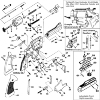The indexing ratchet, or cylinder star, is under exceptionally small load during normal use, so we’re really not talking about a high galling service. Abusing the revolver CAN damage the indexing ratchet and hand, but if you’re abusing a revolver, you would know it.
HOWEVER...
Given the same frame size, a cylinder with MORE chambers will 1) have lighter weight because of addition chambers, and 2) have to rotate LESS during each advance. It will ALSO have the exact same size of hand interface - the driving contact surface of the hand against the ratchet. So it’s actually easier to roll the cylinder of a “high cap” revolver than to roll that of a 6 shot. Think about it this way - advancing a 7-8 shot cylinder instead of a 6 is like pushing a LIGHTER car a shorter distance: which is easier, pushing a heavier car farther, or pushing a lighter car shorter? Pretty simple.
Many folks see all of the material behind each tooth on the ratchet which simply was not milled away - because it’s impertinent to do so - and they assume it is structurally contributing to the mechanical strength of the system. It is not. That extra steel on the back side of the tooth, the comparative extra steel which has to be killed away when adding an extra tooth or two to the ratchet, is just extra, and does not add any strength to the design.
We’re talking about a mechanical system in which only a few thousandths of galling on the SURFACE of the tooth will constitute “damage” or “failure.” You’ll have timing issues with only a few thousandths of galling on that surface. These teeth do not bend, they don’t break, but rather they gall. The tips of HANDS can and do break, but the indexing ratchet durability and strength is really a matter of material hardness, not structural integrity through physical mass.
In parallel, when people see tiny teeth on a gear - which the indexing ratchet is NOT a “gear” anyway, they tend to assume fragility. But often, this is a gross misunderstanding of mechanical design. In gears - which the indexing ratchet is NOT - increasing tooth count can increase durability by increasing the mesh contact between the driven input and slave output gear. Simply, more teeth means smaller teeth, but it also means less stress on each tooth - so when I hear the common misconception regurgitated by anyone that smaller teeth will mean lower durability, I challenge their true understanding of the mechanical system. But again, none of this actually applies, because indexing ratchets are NOT gears, and indexing ratchet teeth macro strength is absolutely not a measure of the revolver’s durability.
Such, it is an absolute fallacy to say a 7 or 8 shot revolver is a weaker design due to the smaller “teeth on the gear.” A 7 or 8 shot revolver will experience LESS stress in each cycle, so that theory is backwards is best, notwithstanding the fact it’s simply NOT an apt analysis of the mechanism in the first place.









